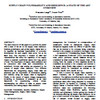 Today’s post is a review of a conference paper written by Francesco Longo and Tuncer Ören in 2008 and presented at a venue where I not would look for papers on supply chain risk: The European Modeling & Simulation Symposium. The paper is titled Supply chain vulnerability and resilience: a state of the art overview, and the main objective, obviously, is to provide the reader with a state of the art review current research on supply chain resilience. And frankly, the paper falls a bit short of doing just that, but it’s nonetheless a paper worth downloading and reading and pondering for any researcher in supply chain risk.
Today’s post is a review of a conference paper written by Francesco Longo and Tuncer Ören in 2008 and presented at a venue where I not would look for papers on supply chain risk: The European Modeling & Simulation Symposium. The paper is titled Supply chain vulnerability and resilience: a state of the art overview, and the main objective, obviously, is to provide the reader with a state of the art review current research on supply chain resilience. And frankly, the paper falls a bit short of doing just that, but it’s nonetheless a paper worth downloading and reading and pondering for any researcher in supply chain risk.
Unlikely, but not that unlikely
I said above that the proceedings of the European Modeling & Simulation Symposium would be an unlikely place for me to look for papers on supply chain risk issues, but when considering Francesco Longo’s research interests, I should perhaps not be that surprised. His research interests include Modeling & Simulation for production systems design and supply chain management, in particular supply chain security, and thus, it is only natural to find him submitting a paper on supply chain vulnerability and resilience at a conference on modeling and simulation.
Opportunities and risks
Right from the start of this paper I was reminded of Trevor Levine’s recent blog post on opportunity and risk, when Longo and Ören in the abstract say that
Markets globalization and global supply chains have to be regarded as business opportunities of economic development for each supply chain actor, but at the same time, they introduce a number of risks and vulnerabilities that affect the capability of the supply chains to maintain equilibrium states over long period of time.
While Trevor poked fun at CME’s TV ad which said that each new opportunity also brings new risk, thus revealing their blatant lack of understanding of what risk really is, Longo and Ören got it right. Opportunities and risks are nothing more than flip sides of the same coin, albeit very different flip sides, I might add.
Resilience explored
The authors make a solid attempt at exploring the topic of resilience in depth. Starting with a list of dictionary definitions, much of their work appears to be based on Sheffi’s Resilient Enterprise and on the research done at the Supply Chain Risk and Resilience project at Cranfield University. Having said that, their literature review lists a number of potentially very promising papers I haven’t heard of before, so I have plenty of future review and blogging work cut out for me here.
Framework for supply chain risk
The two frameworks for supply chain risk analysis they eluded to in the abstract are very familiar. They are Christopher’s five types of supply chain risk and Peck’s four levels of supply chain vulnerability. Alas, nothing revolutionary, but it’s nice to find these two side by side, as I use them in my lecture on supply chain risk.
Supply chain change management
What is interesting about this paper are their suggestions for how modeling and simulation tools (M&S) can be applied to supply chain management:
- tactical, strategic and operative analysis of the decisions tools used for supply chain change management (from the perspective of resilience)
- enhancement of the decisions tools for supply change management including specific toolkits for risks categorization and analysis
- development of decisions models and operative tools for supply chain change management in order to reduce vulnerability and increase resilience and security
- scenarios planning and development for decisional models and operative tools verification, validation and testing (VV&T)
The authors point to the following issues as important future areas for M&S:
- Supply chain vulnerability, security and resilience management
- Demand forecasting and supply risks analysis
- Information management and visibility along the supply chain
- Supply chain life cycle costing
The list could possibly be endless, I guess, as M&S is applicable everywhere. The difficulty may be finding a model that truly captures the volatility of supply chains and the actions of all the parties involved in running a supply chain.
Conclusion
For a state of the art overview, this paper is rather short. Although it has managed to capture some of the essential publications related to supply chain vulnerability and resilience, it falls a bit short of being the state of the art overview the conclusion claims it to be:
The paper proposes an exhaustive state of the art overview on supply chain vulnerability and resilience.
Nonetheless, the paper does have a very important message, namely that modelling and simulation is an essential tool for making decisions in supply chain management:
Modeling & Simulation (M&S) provides an ideal framework for experiencing critical events, understanding the effects of risks on supply chain vulnerability, testing scenarios and evolutionary contexts, measuring supply chain resilience.
Reference
Longo, F. and Ören, T. (2008). Supply chain vulnerability and resilience: a state of the art overview, Proceedings of European Modeling & Simulation Symposium, 17-19 September 2008, Campora S. Giovanni (CS) Italy.
Author links
- unical.it: Francesco Longo
- ottawa.ca: Tuncer Ören
Read online/download
- uottawa.ca: Supply chain vulnerability and resilience
Related posts
- husdal.com: What goes into resilience?
- husdal.com: Supply chain risk – the forgotten discipline?
- husdal.com: Supply chain security and visibility












